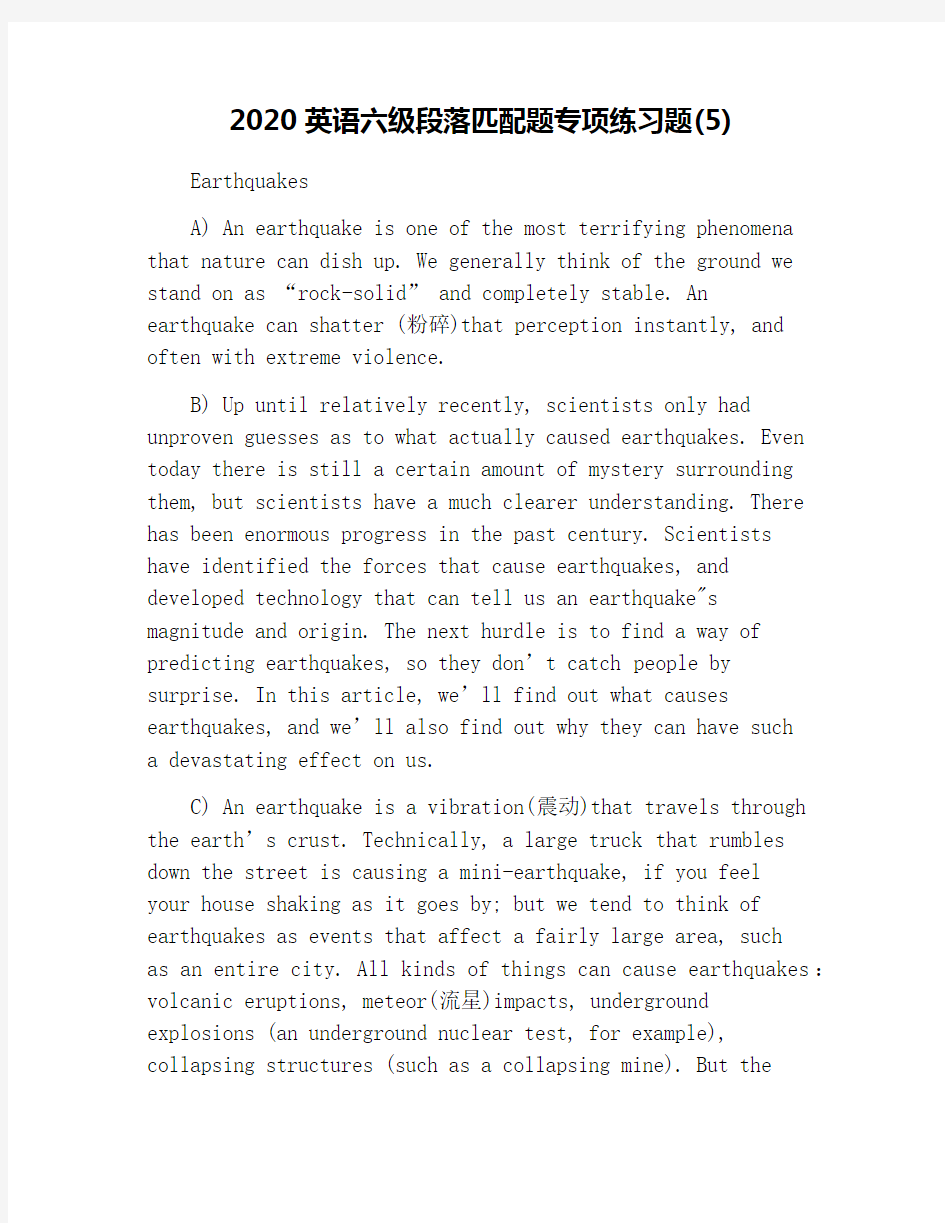

2020英语六级段落匹配题专项练习题(5) Earthquakes
A) An earthquake is one of the most terrifying phenomena that nature can dish up. We generally think of the ground we stand on as “rock-solid” and completely stable. An earthquake can shatter (粉碎)that perception instantly, and often with extreme violence.
B) Up until relatively recently, scientists only had unproven guesses as to what actually caused earthquakes. Even today there is still a certain amount of mystery surrounding them, but scientists have a much clearer understanding. There has been enormous progress in the past century. Scientists have identified the forces that cause earthquakes, and developed technology that can tell us an earthquake"s magnitude and origin. The next hurdle is to find a way of predicting earthquakes, so they don’t catch people by surprise. In this article, we’ll find out what causes earthquakes, and we’ll also find out why they can have such
a devastating effect on us.
C) An earthquake is a vibration(震动)that travels through the earth’s crust. Technically, a large truck that rumbles down the street is causing a mini-earthquake, if you feel
your house shaking as it goes by; but we tend to think of earthquakes as events that affect a fairly large area, such
as an entire city. All kinds of things can cause earthquakes:volcanic eruptions, meteor(流星)impacts, underground
explosions (an underground nuclear test, for example), collapsing structures (such as a collapsing mine). But the
majority of naturally-occurring earthquakes are caused by movements of the earth’s plates.
D) We only hear about earthquakes in the news every once in a while, but they are actually an everyday occurrence on our planet. According to the United States Geological Survey, more than 3 million earthquakes occur every year. That’s about 8,000 a day, or one every 11 seconds! The vast majority of these 3 million quakes are extremely weak. The law of probability also causes a good number of stronger quakes to happen in uninhabited places where no one feels them. It is the big
quakes that occur in highly populated areas that get our attention.
E) Earthquakes have caused a great deal of property damage over the years, and they have claimed many lives. In the last hundred years alone, there have been more than 1.5 million earthquake-related fatalities. Usual ly, it’s not the shaking ground itself that claims lives; it’s the associated destruction of man-made structures and other natural disasters it causes, such as tsunamis, avalanches (雪崩)and landslides.
F) The biggest scientific breakthrough in the history of seismology—the study of earthquakes—came in the middle of the 20th century, with the development of the theory of plate tectonics(筑造学).Scientists proposed the idea of plate tectonics to explain a number of peculiar phenomena on earth, such as the apparent movement of continents over time, the clustering of volcanic activity in certain areas and the presence of huge ridges at the bottom of the ocean.
G) The basic theory is that the surface layer of the earth—the lithosphere—is comprised of many plates that
slide over the lubricating (润滑的)asthenosphere layer. At the boundaries between these huge plates of soil and rock, three different things can happen.
H) Plates can move apart. If two plates are moving apart from each other, hot, molten rock flows up from the layers of mantle below the lithosphere. This magma (岩浆) comes out on the surface (mostly at the bottom of the ocean), where it is called lava (熔岩).As the lava cools, it hardens to form new lithosphere material, filling in the gap. This is called a divergent plate boundary.
I) Plates can push together. If the two plates are moving toward each other, one plate typically pushes under the other one. This plate below sinks into the lower mantle layers, where it melts. At some boundaries where two plates meet, neither plate is in a position to push under the other, so they both push against each other to form mountains. The
lines where plates push toward each other are called convergent plate boundaries.
J) Plates slide against each other. At other boundaries, plates simply slide by each other—one moves north and one moves south, for example. While the plates don’t drift directly into each other at these transform boundaries, they are pushed tightly together. A great deal of tension builds at the boundary.
K) We understand earthquakes a lot better than we did even 50 years ago, but we still can’t do much about them. They are caused by fundamental, powerful geological processes